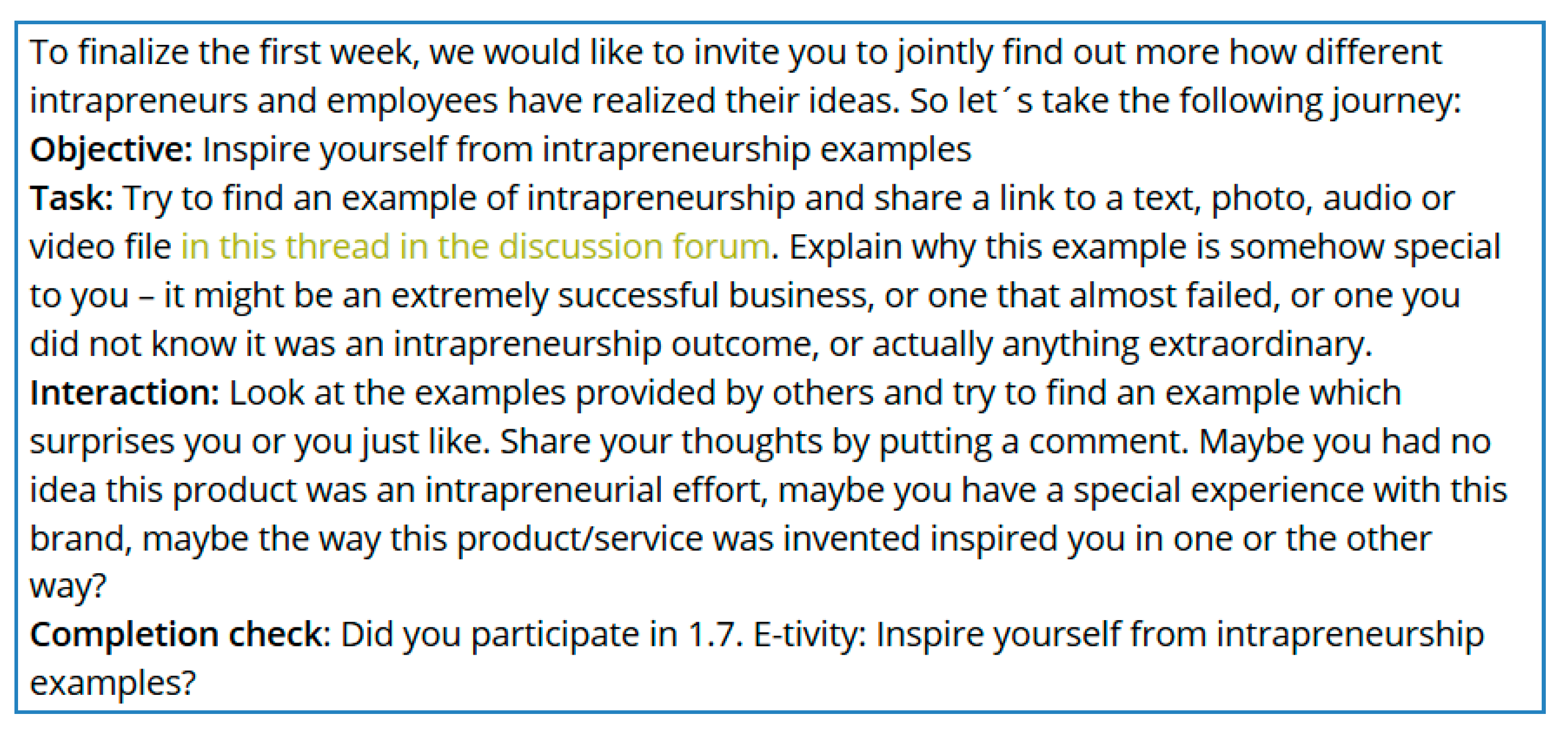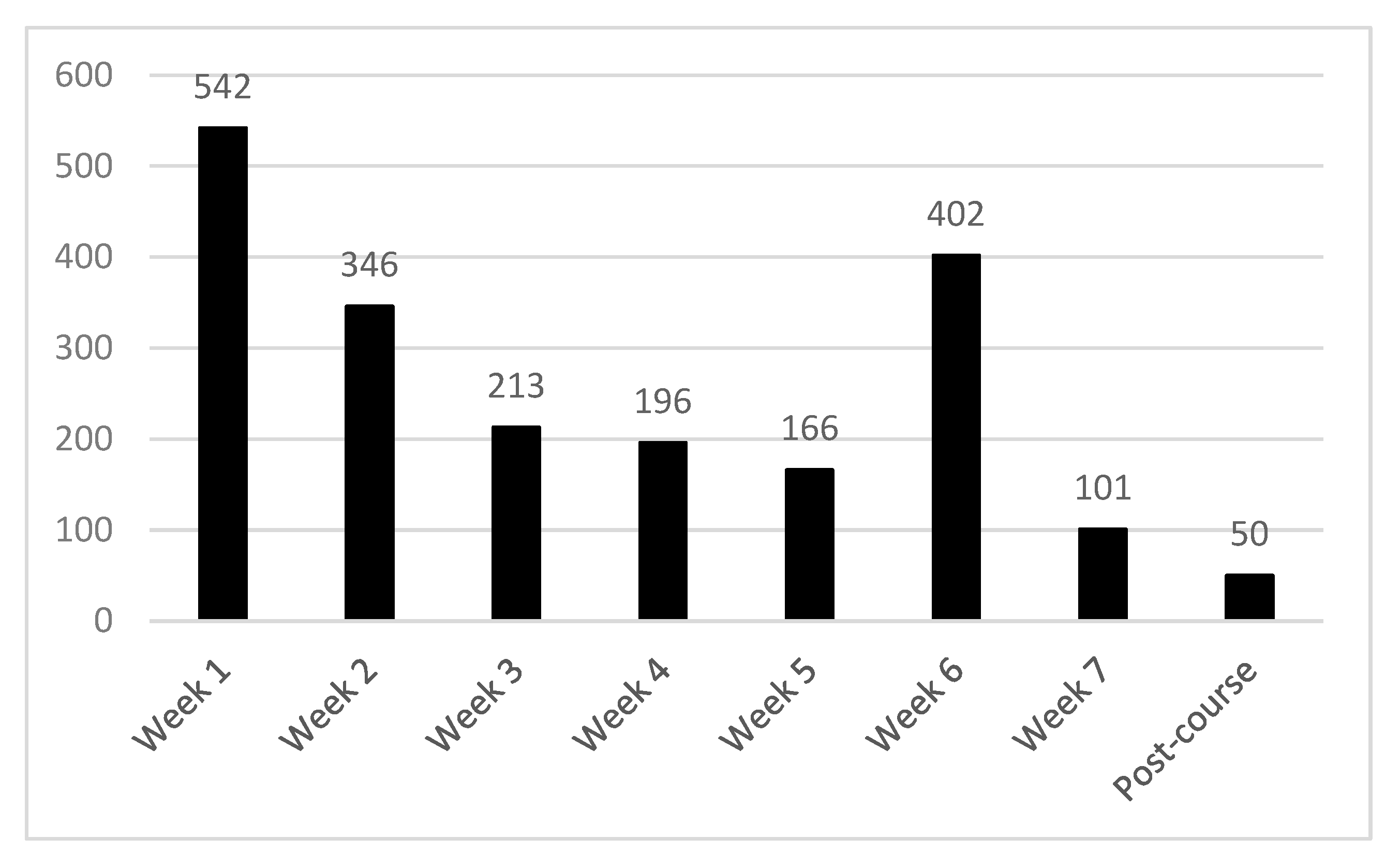Two Heads Are Better Than One—Entrepreneurial Continuous Learning through Massive Open Online Courses
Abstract
1. Introduction
2. Theoretical Background
2.1. Continuous Entrepreneurial Education in the Digital Age
2.2. Massive Open Online Courses
3. Research Design
4. Case Study
4.1. MOOC Development Process
4.2. Outcomes
5. Discussion
6. Conclusions, Limitations and Future Research
Funding
Conflicts of Interest
References
- Lewrick, M.; Omar, M.; Raeside, R.; Sailer, K. Education for entrepreneurship and innovation: Management capabilities for sustainable growth and success. World J. Entrep. Manag. Sustain. Dev. 2011, 6, 1–18. [Google Scholar] [CrossRef]
- Yin, R.K. Case Study Research and Applications: Design and Methods; Sage Publications: New York, NY, USA, 2017. [Google Scholar]
- Pasieczny, J.; Glinka, B. Organizational dysfunctions: Sources and areas. Entrep. Bus. Econ. Rev. 2016, 4, 213–223. [Google Scholar] [CrossRef]
- Postuła, A.; Majczyk, J. Managers and Leaders in Need of Entrepreneurial Competences. Entrep. Bus. Econ. Rev. 2018, 6, 91–103. [Google Scholar] [CrossRef]
- Sady, M.; Żak, A.; Rzepka, K. The Role of Universities in Sustainability-Oriented Competencies Development: Insights from an Empirical Study on Polish Universities. Adm. Sci. 2019, 9, 62. [Google Scholar] [CrossRef]
- Santandreu-Mascarell, C.; Garzon, D.; Knorr, H. Entrepreneurial and innovative competences, are they the same? Manag. Decis. 2013, 51, 1084–1095. [Google Scholar] [CrossRef]
- Kakouris, A. Entrepreneurship pedagogies in lifelong learning: Emergence of criticality? Learn. Cult. Soc. Interact. 2015, 6, 87–97. [Google Scholar] [CrossRef]
- Nabi, G.; Liñán, F.; Fayolle, A.; Krueger, N.; Walmsley, A. The impact of entrepreneurship education in higher education: A systematic review and research agenda. Acad. Manag. Learn. Educ. 2017, 16, 277–299. [Google Scholar] [CrossRef]
- Kimiloglu, H.; Ozturan, M.; Kutlu, B. Perceptions about and attitude toward the usage of e-learning in corporate training. Comput. Hum. Behav. 2017, 72, 339–349. [Google Scholar] [CrossRef]
- Acs, Z.J.; Audretsch, D.B.; Lehmann, E.E. The knowledge spillover theory of entrepreneurship. Small Bus. Econ. 2013, 41, 757–774. [Google Scholar] [CrossRef]
- Autio, E.; Nambisan, S.; Thomas, L.D.; Wright, M. Digital affordances, spatial affordances, and the genesis of entrepreneurial ecosystems. Strateg. Entrep. J. 2018, 12, 72–95. [Google Scholar] [CrossRef]
- Helfat, E.C.; Raubitschek, R.S. Dynamic and integrative capabilities for profiting from innovation in digitalplatform-based ecosystems. Res. Policy 2018, 47, 1391–1399. [Google Scholar] [CrossRef]
- Teece, D.J. Dynamic capabilities and (digital) platform lifecycles. Entrepreneurship, Innovation, and Platforms 2017, 37, 211–225. [Google Scholar]
- European Parliament and Council. Recommendation of the European Parliament and of the Council of 18 December 2006 on Key Competences for Lifelong Learning; European Commission: Brussels, Belgium, 2006; pp. 10–18. [Google Scholar]
- Rae, D. Entrepreneurial learning: A narrative-based conceptual model. J. Small Bus. Enterp. Dev. 2005, 12, 323–335. [Google Scholar] [CrossRef]
- Delgado-Algarra, E.J.; Román-Sánchez, I.M.; Ordonez Olmedo, E.; Lorca-Marín, A.A. International MOOC Trends in Citizenship, Participation and Sustainability: Analysis of Technical, Didactic and Content Dimensions. Sustainability 2019, 11. [Google Scholar] [CrossRef]
- Gibb, A.A. In pursuit of a new enterprise and entrepreneurship paradigm for learning: Creative destruction, new values, new ways of doing things and new combinations of knowledge. Int. J. Manag. Rev. 2002, 4, 213–232. [Google Scholar] [CrossRef]
- Pittaway, L.; Cope, J. Simulating entrepreneurial learning: Integrating experiential and collaborative approaches to learning. Manag. Learn. 2007, 38, 211–233. [Google Scholar] [CrossRef]
- Dodson, M.N.; Kitburi, K.; Berge, Z.L. Possibilities for MOOCs in corporate training and development. Perform. Improv. 2015, 54, 14–21. [Google Scholar] [CrossRef]
- Pisoni, G. Strategies for pan-european implementation of blended learning for innovation and entrepreneurship (i&e) education. Educ. Sci. 2019, 9, 124. [Google Scholar] [CrossRef]
- Morcillo, P.; Rodriguez-Anton, J.M.; Rubio, L. Corporate culture and innovation: In search of the perfect relationship. Int. J. Innov. Learn. 2007, 4, 547–570. [Google Scholar] [CrossRef]
- Ellis, P.F.; Kuznia, K.D. Corporate eLearning impact on employees. Glob. J. Bus. Res. 2014, 8, 1–15. [Google Scholar]
- Chen, E.T. Successful E-Learning in corporations. Commun. IIMA 2008, 8, 45–54. [Google Scholar]
- Strother, J.B. An assessment of the effectiveness of e-learning in corporate training programs. Int. Rev. Res. Open Distrib. Learn. 2002, 3, 1–17. [Google Scholar] [CrossRef]
- Adler, P.S.; Kwon, S.W. Social capital: Prospects for a New Concept. Acad. Manag. Rev. 2002, 27, 17–40. [Google Scholar] [CrossRef]
- Clarysse, B.; Wright, M.; Bruneel, J.; Mahajan, A. Creating value in ecosystems: Crossing the chasm between knowledge and business ecosystems. Res. Policy 2014, 43, 1164–1176. [Google Scholar] [CrossRef]
- Jack, S.L. The Role, Use and Activation of Strong and Weak Network Ties: A Qualitative Analysis. J. Manag. Stud. 2005, 42, 1233–1259. [Google Scholar] [CrossRef]
- Uzzi, B. Social Structure and Competition in Interfirm Networks: The Paradox of Embeddedness. Adm. Sci. Q. 1997, 42, 35–67. [Google Scholar] [CrossRef]
- Jaffe, A.B. Technological opportunity and spillovers of R&D: Evidence from firms’ patents profits, and market value. Am. Econ. Rev. 1986, 76, 984–1001. [Google Scholar]
- Li, W.; Badr, Y.; Biennier, F. Digital ecosystems: Challenges and prospects. In Proceedings of the International Conference on Management of Emergent Digital EcoSystems, ACM, Addis Ababa, Ethiopia, 28–31 October 2012; pp. 117–122. [Google Scholar]
- Jansen, D.; Schuwer, R. Institutional MOOC Strategies in Europe Status Report Based on a mApping Survey Conducted in October–December 2014; EADTU: Maastricht, The Netherlands, 2018; Available online: https://www.surfspace.nl/media/bijlagen/artikel-1763-22974efd1d43f52aa98e0ba04f14c9f3.pdf (accessed on 18 October 2019).
- Meinel, C.; Schweiger, S.A. Virtual Social Learner Community—Constitutive Element of MOOCs. Educ. Sci. 2016, 6. [Google Scholar] [CrossRef]
- Siemens, G. Connectivism: A learning theory for the digital age. Int. J. Ind. Technol. Distance Learn. 2005, 2, 3–10. [Google Scholar]
- Najafi, H.; Rolheiser, C.; Håklev, S.; Harrison, L. Variations in Pedagogical Design of Massive Open Online Courses (MOOCs) Across Disciplines. Teach. Learn. Inq. 2017, 5, 47–64. [Google Scholar] [CrossRef]
- Karlsson, N.; Godhe, A.L. Creating a Community Rather Than a Course—Possibilities and Dilemmas in an MOOC. Educ. Sci. 2016, 6. [Google Scholar] [CrossRef]
- Conole, G.G. MOOCs as disruptive technologies: Strategies for enhancing the learner experience and quality of MOOCs. Rev. Educ. Distancia 2013, 39. Available online: https://revistas.um.es/red/article/view/234221 (accessed on 12 November 2019). [CrossRef]
- Fournier, H.; Kop, R.; Durand, G. Challenges to research in MOOCs. MERLOT J. Online Learn. Teach. 2014, 10, 1–15. [Google Scholar]
- Kizilcec, R.F.; Saltarelli, A.J.; Reich, J.; Cohen, G.L. Closing global achievement gaps in MOOCs. Science 2017, 355, 251–252. [Google Scholar] [CrossRef]
- Zawacki-Richter, O.; Bozkurt, A.; Alturki, U.; Aldraiweesh, A. What research says about MOOCs–An explorative content analysis. Int. Rev. Res. Open Distrib. Learn. 2018, 19, 242–259. [Google Scholar] [CrossRef]
- Antoncic, J.; Antoncic, B. Employee satisfaction, intrapreneurship and firm growth: A model. Ind. Manag. Data Syst. 2011, 111, 589–607. [Google Scholar] [CrossRef]
- Creswell, J.W. Qualitative Inquiry and Research Design: Choosing Among Five Traditions; Sage: Thousand Oaks, CA, USA, 1998. [Google Scholar]
- Lee, A.S. Case studies as natural experiments. Hum. Relat. 1989, 42, 117–137. [Google Scholar] [CrossRef]
- Onah, D.F.; Sinclair, J.; Boyatt, R. Dropout rates of massive open online courses: Behavioural patterns. EDULEARN14 Proc. 2014, 1, 5825–5834. [Google Scholar]
- Salmon, G. E-Tivities, the Key to Active Online Learning, 2nd ed.; Routlegde: London, UK; New York, NY, USA, 2013. [Google Scholar]
- Ghio, N.; Guerini, M.; Lehmann, E.E.; Rossi-Lamastra, C. The emergence of the knowledge spillover theory of entrepreneurship. Small Bus. Econ. 2015, 44, 1–18. [Google Scholar] [CrossRef]
- Sternberg, R. Entrepreneurship, Proximity and Regional Innovation Systems. Tijdschr. Voor Econ. En Soc. Geogr. 2007, 98, 652–666. [Google Scholar] [CrossRef]
- Caseiro, N.; Coelho, A. The influence of Business Intelligence capacity, network learning and innovativeness on startups performance. J. Innov. Knowl. 2019, 4, 139–145. [Google Scholar] [CrossRef]
- Dini, P.; Iqani, M.; Mansell, R. The (im)possibility of interdisciplinary lessons from constructing a theoretical framework for digital ecosystems. Cult. Theory Crit. 2011, 52, 3–27. [Google Scholar] [CrossRef]
- Yang, L.X.; Yang, X.; Zhijun, Z. MOOC: A New Mode of Integrating and Sharing Knowledge Resources in Colleges and Universities. In Proceedings of the 2016 8th International Conference on Information Technology in Medicine and Education (ITME), Fuzhou, China, 23–25 December 2016. [Google Scholar]
- Feld, B. Startup Communities: Building an Entrepreneurial Ecosystem in Your City; Wiley: New York, NY, USA, 2012. [Google Scholar]
- Kim, P.; Chung, C. Creating a temporary spontaneous mini-ecosystem through a MOOC. In MOOCs and Open Education Around the World; Bonk, C.J., Lee, M.M., Reeves, T.C., Reynolds, T.H., Eds.; Routlegde: New York, NY, USA, 2015; pp. 157–168. [Google Scholar]


| Examples of Respondents’ Testimonies | Emergent Themes |
|---|---|
| I learned so much about intrapreneurship in so many organisations. I value most the opportunity to learn about so many examples on intrapreneurship—now I know this can be real. |  Learning about the practice of intrapreneurship Learning about the practice of intrapreneurship |
| This course strengthened my mindset—anyone can be entrepreneurial. I see the full spectrum of potential that employees hold for the organisation. I gained a new business perspective. I will be keeping an eye out for new ideas of my employees. |  Changing perceptions and mindsets Changing perceptions and mindsets |
| I see that my company really needs to update its business model. I have so many new ideas now. I have specific ideas that I want to implement in my business. |  New ideas for work/own business New ideas for work/own business |
| People shared so many useful work-arounds. I learned many new practices from others that I can adopt in my work. Through teamwork, we developed new tools for communicating new ideas and pushing them through. I found the tips on how to build coalitions more helpful. |  Practical tools and solutions for work Practical tools and solutions for work |
| It was a fun learning process. I managed to keep up and enjoyed it. It’s a quick way to get up-to-date knowledge from around the world. It was great to learn from people who know so much more than I, and I could learn on my own terms. The flexibility of learning is a huge advantage. It can be addictive, I hope my next MOOC will be just as interesting. |  Stimulation and reinforcement for further education Stimulation and reinforcement for further education |
| It was possible to learn practical little things that you will never read about. I love that people were so open, although they were on the other side of the globe. Everyone was equal in the discussion forums and we addressed each other by our first names. People revealed as much as they wanted about themselves, this was comfortable. |  Exchange of tacit knowledge Exchange of tacit knowledge |
© 2020 by the author. Licensee MDPI, Basel, Switzerland. This article is an open access article distributed under the terms and conditions of the Creative Commons Attribution (CC BY) license (http://creativecommons.org/licenses/by/4.0/).
Share and Cite
Żur, A. Two Heads Are Better Than One—Entrepreneurial Continuous Learning through Massive Open Online Courses. Educ. Sci. 2020, 10, 62. https://doi.org/10.3390/educsci10030062
Żur A. Two Heads Are Better Than One—Entrepreneurial Continuous Learning through Massive Open Online Courses. Education Sciences. 2020; 10(3):62. https://doi.org/10.3390/educsci10030062
Chicago/Turabian StyleŻur, Agnieszka. 2020. "Two Heads Are Better Than One—Entrepreneurial Continuous Learning through Massive Open Online Courses" Education Sciences 10, no. 3: 62. https://doi.org/10.3390/educsci10030062
APA StyleŻur, A. (2020). Two Heads Are Better Than One—Entrepreneurial Continuous Learning through Massive Open Online Courses. Education Sciences, 10(3), 62. https://doi.org/10.3390/educsci10030062





